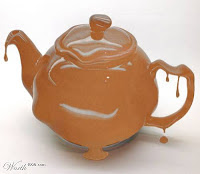I felt I had to convey my frustrations as a post. Frustrations that apply to a few research projects I am involved in. Projects that are qualitative and ethnographic.
Let me start here; years ago when I was at JWT (1994-1998) running an ethnographic unit called InSitu, a senior planner complained that a research agency (to remain unnamed) preyed on naive client side research managers by waving ridiculous and meaningless process driven research methods at them. Some bit on the hook, some didn't.
Let us now leap to 2013: Too many of us don't spend enough time immersing ourselves in observational data/video. Not because we don't have time, but because we don't know how to. Instead we spend hundreds of worthless man hours 'analysing' the observational data by coding it. Make no mistake, coding is essential to help us make sense of the lego pieces of film, pictures, audio and text that have landed on our desk(top)s resembling a small mountain of rubbish. But coding can also de-contextualise incredibly rich sequences of events. Coding can become a lens that actually serves to obscure events and their meanings.
It has been possible for a while, for example, to transcribe video into text in such a way that when individual words are highlighted, will fast forward the film to the precise points where the word is spoken. What makes it powerful is that you can select many words in the same way and view the sequences of film together to compare. It also saves an awful lot of time. But does it help you understand and deconstruct events? If you want rigour, coding is great for quantitative surveys. But coding qualitative data like it's a quant survey is a time wasting, client mollifying mistake.
So why will we be offering the same transcription tool? Because we want users to have access to everything they think they will need. In the same way my washing machine has a cashmere wash. Which incidentally I will never ever use. Just wash it by hand for goodness sake.
Let's leap somewhere else: After a few hundred hours of viewing transcribed and digitally synced video, you still have to make sense of it. Add meaning to it and translate it into action. This bit is called interpretation. And it never ceases to amaze me how many agency presenters at conferences share outputs which are analysis (voxpops, out takes, etc.) disguised as interpretation.
Then you can get the clever anthropologists who use wonderful grounded theory methods to make sense of essentially messy data. But very few of them, just like researchers and planners, are able to make sense of what they are seeing in such a way that lifts and transforms a series of happenings into powerful meanings and actions.
One last leap. You want to understand naturally occurring ethnographic video? Watch it. From beginning to end. Then watch it again and again. Each time writing notes, each time see something you didn't see or think of before. It's very messy data, and easy to try to make sense of the wrong way.
You can try coding ethnographic data, but it's a little like trying to construct a chocolate teapot. It looks great, but not much use when you try to use it. And believe me you will, at some point during your analysis phase, begin to wonder how much more you might have seen by treating the events, speech and behaviours not as discreet standalone events, but as interconnected ones that need to be understood as a whole. You will also wish that you had involved the researcher and the participant themselves in the process of discovery.
And you know what it takes? Creativity and intuition. Remember, research only gives you understanding. Your creativity and intuition tempered by your understanding provide the answers. Something sadly lacking in research these days.






Right on.
ReplyDeleteThis post reminded of something I came across a few years ago, something I’ll share, but first let me agree with your warnings and your call to become more courageous. Coding can all too easily become an “end” rather than the means to an end. It’s liable to dishonor the /sohbet/ between us as observers and who/what we’re observing. I’ll let you elaborate on that concept, if it makes sense to you and if you’re so inclined. An overreliance on coding, out of fear or inexperience, can diminish our understanding of the multiple ways in which observed events are culturally embedded in their own contexts and the multiple ways in which their wholeness and integrity are individually and collectively represented. Even worse is when distracting and obstructive coding reduces observed events to static rather than dynamic phenomena. Yet we need some structure in our inquiry, at least a semi-structured approach in our coding, to nourish the connection between us and the objects of our studies and to promote a victorious rather than a vicious hermeneutic circle.
ReplyDeleteYour compelling image of the chocolate teapot conjured up for me an illustration marshaled by a discourse analyst by the name of Leo van Lier. To make his point that discourse, if nothing else, is “movement, change, and cumulative achievement,” van Lier recommended “an analysis of successive states, rather like examining a film frame by frame, or by regarding our transcript as similar to Duchamp’s painting Nude descending a staircase, where an illusion of movement is created by showing the body in a series of successive, overlapping postures. Whichever way we slow down the movement by artificial or artful means, the movement must not be lost or else we will no longer be studying discourse (van Lier 1984, I’d be glad to supply the citation).”
http://en.wikipedia.org/wiki/File:Duchamp_-_Nude_Descending_a_Staircase.jpg
Celia said it best, “Right on.”